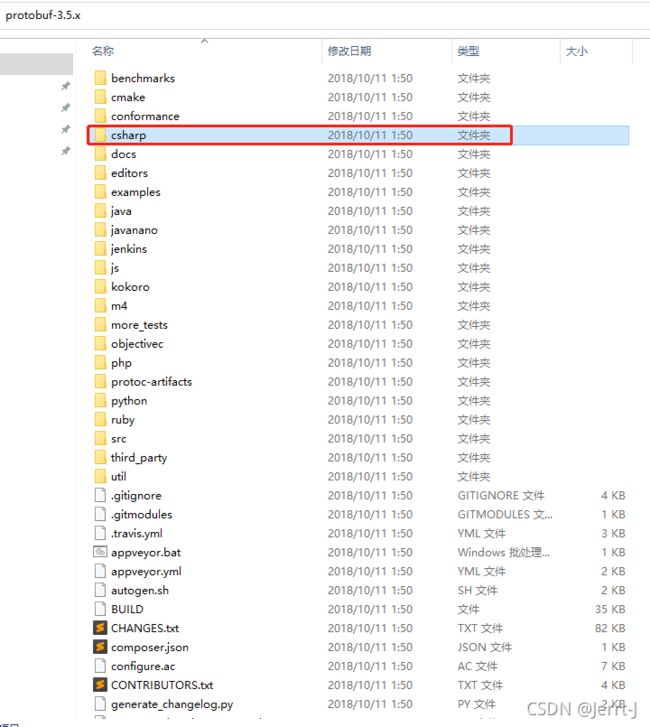Unity中使用ProtoBuf-保姆式教程
·ProtoBuf介绍
ProtoBuf 是结构数据序列化方法,可简单类比于 XML、JSON,其具有以下特点:
- 语言无关、平台无关。即 ProtoBuf 支持 Java、C++、Python 等多种语言,支持多个平台
- 高效。即比 XML 更小(3 ~ 10倍)、更快(20 ~ 100倍)、更为简单
- 扩展性、兼容性好。你可以更新数据结构,而不影响和破坏原有的旧程序
·ProtoBuf获取
我这边选择的版本为 ProtoBuf 3.5.x
一共需要两个步骤
1.Google.Protobuf
从GitHub上获取完整版 传送门, 选择3.5.x的版本
这里有2条方式可供选择
(1)在unity中使用源码
Google.Protobuf这个文件夹直接放入到unity中
(2)在unity中使用Google.Protobuf.dll
使用vs打开它,用release去编译Google.Protobuf这个工程,在release这个目录下你会得到这个dll,放入到你的Libraries中
2.Protoc
从GitHub上获取windows版本 传送门, 选择3.5.1的版本
在bin中找到我们要的protoc.exe
写好 proto 文件之后用 protoc 编译器将 .proto文件编译成目标语言。
·.proto文件
测试文件内容
// 指定版本
syntax = "proto3";
// C#中的namespace
package ProtoTest
option optimize_for = SPEED;
// java文件路径
option java_package = "com.montior.proto";
// java文件名称
option java_outer_classname = "MonitorData";
// 消息结果。
message MsgResult {
// 结果码。
int32 code = 1;
// 错误消息。
string err_msg = 2;
}
// 接收包
message TaskProtocol {
// 数据类型
int32 packType = 1;
// 具体数据
bytes content = 3;
}
// 包的类型
enum PackType {
LOGIN = 0;
CREATE_TASK = 2;
DELETE_TASK = 3;
}
message LoginPack{
string username = 1;
}
message LoginPack2{
string username = 1;
}
message CreateTaskPack{
string taskId = 1;
string taskName = 2;
}-
message:消息类型,类似于一个类
-
package:包名,CSharp中的命名空间,用来防止不同消息类型的冲突
-
enum:枚举,这个需要我说吗?
-
option:选项,说明下我这边用到的
option java_package = “com.example.foo”;// java文件路径
option java_outer_classname = “Ponycopter”;// java文件名称
option optimize_for = SPEED;//可以被设置为 SPEED, CODE_SIZE,or LITE_RUNTIME。这些值将通过如下的方式影响C++及java代码的生成:注:以上选项,CSharp都用不着的,就是写着玩儿....
- 数据类型
protobuf 数据类型
描述
C++
bool
布尔类型
bool
double
64位浮点数
double
float
32为浮点数
float
int32
32位整数、
int
uin32
无符号32位整数
unsigned int
int64
64位整数
__int64
uint64
64为无符号整
unsigned __int64
sint32
32位整数,处理负数效率更高
int32
sing64
64位整数 处理负数效率更高
__int64
fixed32
32位无符号整数
unsigned int32
fixed64
64位无符号整数
unsigned __int64
sfixed32
32位整数、能以更高的效率处理负数
unsigned int32
sfixed64
64为整数
unsigned __int64
string
只能处理 ASCII字符
std::string
bytes
用于处理多字节的语言字符、如中文
std::string
- 关键字
指定字段 说明 required 表示是一个必须字段,必须相对于发送方,在发送消息之前必须设置该字段的值,对于接收方,必须能够识别该字段的意思。发送之前没有设置required字段或者无法识别required字段都会引发编解码异常,导致消息被丢弃。 optional 表示是一个可选字段,可选对于发送方,在发送消息时,可以有选择性的设置或者不设置该字段的值。对于接收方,如果能够识别可选字段就进行相应的处理,如果无法识别,则忽略该字段,消息中的其它字段正常处理。---因为optional字段的特性,很多接口在升级版本中都把后来添加的字段都统一的设置为optional字段,这样老的版本无需升级程序也可以正常的与新的软件进行通信,只不过新的字段无法识别而已,因为并不是每个节点都需要新的功能,因此可以做到按需升级和平滑过渡。 repeated 表示该字段可以包含0~N个元素。其特性和optional一样,但是每一次可以包含多个值。可以看作是在传递一个数组的值。
·在Unity的布局
UnityProject
-Asset
--Libraries
---Google.Protobuf // Protobuf源文件/dll文件
--Scripts/Editor/Proto2CSEditor // 放置.proto文件转化为cs的代码
--Scripts/ProtoMessage // 放置转化的cs的代码
-Proto
--monitorData.proto //放置.proto文件
--protoc.exe //
·如何使用protoc.exe把.proto文件转化为.cs
[MenuItem("Tools/Proto2CS")]
public static void AllProto2CS()
{
string rootDir = Environment.CurrentDirectory;
string protoDir = Path.Combine(rootDir, "Proto/");
string protoc;
if (RuntimeInformation.IsOSPlatform(OSPlatform.Windows))
{
protoc = Path.Combine(protoDir, "protoc.exe");
}
else
{
protoc = Path.Combine(protoDir, "protoc");
}
string hotfixMessageCodePath = Path.Combine(rootDir, "Assets", "Scripts", "ProtoMessage/");
string argument2 = $"--csharp_out=\"{hotfixMessageCodePath}\" --proto_path=\"{protoDir}\" monitorData.proto";
Run(protoc, argument2, waitExit: true);
UnityEngine.Debug.Log("proto2cs succeed!");
AssetDatabase.Refresh();
}
public static Process Run(string exe, string arguments, string workingDirectory = ".", bool waitExit = false)
{
try
{
bool redirectStandardOutput = true;
bool redirectStandardError = true;
bool useShellExecute = false;
if (RuntimeInformation.IsOSPlatform(OSPlatform.Windows))
{
redirectStandardOutput = false;
redirectStandardError = false;
useShellExecute = true;
}
if (waitExit)
{
redirectStandardOutput = true;
redirectStandardError = true;
useShellExecute = false;
}
ProcessStartInfo info = new ProcessStartInfo
{
FileName = exe,
Arguments = arguments,
CreateNoWindow = true,
UseShellExecute = useShellExecute,
WorkingDirectory = workingDirectory,
RedirectStandardOutput = redirectStandardOutput,
RedirectStandardError = redirectStandardError,
};
Process process = Process.Start(info);
if (waitExit)
{
process.WaitForExit();
if (process.ExitCode != 0)
{
throw new Exception($"{process.StandardOutput.ReadToEnd()} {process.StandardError.ReadToEnd()}");
}
}
return process;
}
catch (Exception e)
{
throw new Exception($"dir: {Path.GetFullPath(workingDirectory)}, command: {exe} {arguments}", e);
}
}·序列化与反序列化
·举个栗子
MsgResult result = new MsgResult
{
Code = -999,
ErrMsg = "Error"
};
TaskProtocol msgResult = new TaskProtocol
{
PackType = 111,
Content = result.ToByteString()
};
byte[] s = packer.SerializeTo(msgResult);
Debug.Log("---------------------------------------------------");
TaskProtocol response = new TaskProtocol();
packer.DeserializeFrom(response, s);
MsgResult responseMsgResult = new MsgResult();
packer.DeserializeFrom(responseMsgResult, response.Content.ToByteArray());
Debug.Log(response.PackType);
Debug.Log(responseMsgResult.Code);
Debug.Log(responseMsgResult.ErrMsg);·Unity中还可以使用protobuf-net.dll
·结语
如果这样你都还配置不好ProtoBuf,不知道怎么序列化和反序列化的话!!!!
那就多看几遍,哈哈哈





